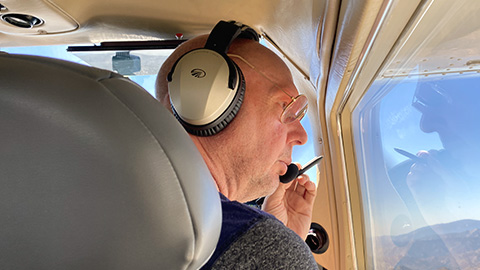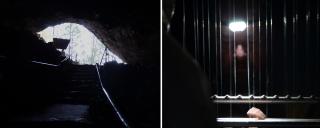
The generator that runs the sodium lights in Minnetonka Cave just outside of St. Charles, Idaho, on the Caribou-Targhee National Forest has been winterized and the lights are off for the season. But just before 6 p.m. on the sixth day of fall, five people wearing headlamps carefully descended about 25 of the cave’s 444 wet, rock steps to the gate.
There they set up a harp trap designed to catch bats as they leave one of the largest hibernacula in the state at dusk.
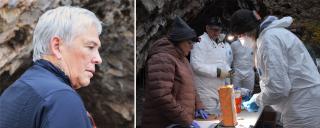
Tonie Rocke, Ph.D., research scientist for the U.S. Geological Survey’s (USGS) National Wildlife Health Center, and an energetic interagency team of biologists dressed head to toe in protective suits and worked feverishly on a cold September night under a full moon. Wearing the protective suit was part of the protocol of the mission when working in bat roosts.
Just outside the mouth of the popular summer tourist attraction, the team tested the efficacy of a potentially lifesaving treatment for the animals. The treatment is a vaccine that helps protect bats from white-nose syndrome, which is caused by a fungal infection. It is one of the most devastating wildlife diseases and has killed millions of bats across North America since its emergence in 2007.
“Vaccinating bats was one of the alternative management strategies identified during our structured decision-making workshop,” said Rita Dixon, Ph.D., state wildlife action plan coordinator for the Idaho Department of Fish and Game. “Because Tonie Rocke had started her vaccine trial, we had the opportunity to work with her to vaccinate bats at Minnetonka Cave as a preventive measure in advance of the disease.”
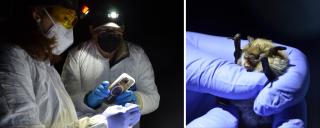
Up until last year, there were no signs of Pseudogymnoascus destructans, or Pd, which is the fungus that causes white-nose syndrome, among the winter residents of the cave. This is the seventh location, including bat colonies and maternity roosts, Rocke’s team has visited this year to administer an experimental vaccine authorized for field trials by the USDA.
Minnetonka Cave serves as a winter roost for at least seven bat species and is one of the largest and most species-rich bat habitats in the state. In June 2022, Idaho Fish and Game found that six bats in this cave tested positive for Pd. These included three species, Little Brown Myotis, Long-legged Myotis, and Yuma Myotis – all of which are susceptible to white-nose syndrome.
The fungus thrives in cold dark environments, grows on a bat’s skin and is easily spread. Pd is normally found within a cave one or two seasons before bats develop white-nose syndrome.
Rocke represents the part of the USGS that conducts research on wildlife diseases. She was onsite with her assistant, Sadie Trombley, and 11 other biologists from the state of Idaho and other federal agencies to vaccinate bats against white-nose syndrome before its arrival in Idaho. This marks the third year of collaboration.
“The partnership is so very important because there are so many moving parts, no one agency could do everything that needs to be done here,” said Mike Larsen, USDA Forest Service wildlife biologist. “The U.S. Geological Survey is leading the research on the vaccine, the U.S. Fish and Wildlife Service is the lead agency for white-nose syndrome, the Idaho Department of Fish and Game manages the wildlife in this state, and the USDA Forest Service manages the cave and the surrounding habitat.”
The biologist team’s experience ranged from a biologist with more than 20 years working with bats to a biologist holding a bat for the first time in her life. The effort at this cave and at a maternity colony in the Oneida Narrows provided rare opportunities to work with many bats in one night. This group set out to capture at least 150 individuals from diverse microbat species. Rocke says the bats are very smart and they rarely catch the same bats twice.
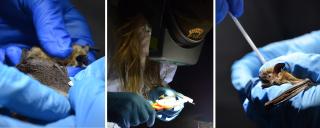
At the processing table, the team weighs the bat, measures the forearm, determines their sex and age, swabs their wing to detect the fungus, gives them a numbered band, puts a few drops of vaccine in their mouths, then releases them. Half of the bats received the vaccine; the other half received a placebo. Because of the time of year, almost all the bats were adults, and the majority were male.
At nearly 11:30 p.m., bat number 153 was weighed. The team’s exhaustion showed as the excitement dwindled to the sounds of only the necessary information that needed to be recorded, screeching of the acoustic app that identifies bats by sound, and flutter of wings as bats dodged between the researchers in the light of the full moon.
Bats are vulnerable to the fungus during hibernation when they become inactive and use less energy. Rocke said the vaccine is mixed with a raccoon pox virus vaccine vector, which is a kind of vaccine that only affects the bats for a short time. The research is to learn whether boosting the bats’ immune system for a little longer will help them ward off the effects of the fungus. The treatment is likely to be most effective prior to or immediately after the fungus shows up in a cave where bats hibernate.
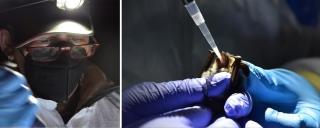
Dixon said they didn’t see any clinical signs of white-nose syndrome or anything else concerning on the bats that took the 10-minute journey through the assembly line. They all seemed to have healthy weights and were well hydrated. But it may be weeks before she learns whether Pd was detected on any of the bats sampled.
“I don’t think things could have gone more smoothly. We had enough experienced people to manage the harp trap, process bats, and get them safely released,” said Dixon. “Everyone had a job and worked as a team, remaining focused on the task. It was a beautiful night, the bats were flying, and we were able to meet our objectives.”
While there is no evidence that the fungus affects humans, pets, livestock, or other wildlife, it has substantially impacted bat populations, including declines of over 90 percent in Northern Myotis, Little Brown Myotis, and Tricolored Bat populations in less than 10 years.
Because most bat species that are affected by white-nose syndrome only produce one to two pups per year, it can take decades or longer for their populations to recover from the devastating mortalities associated with white-nose syndrome.




